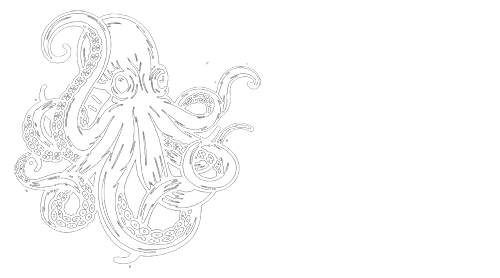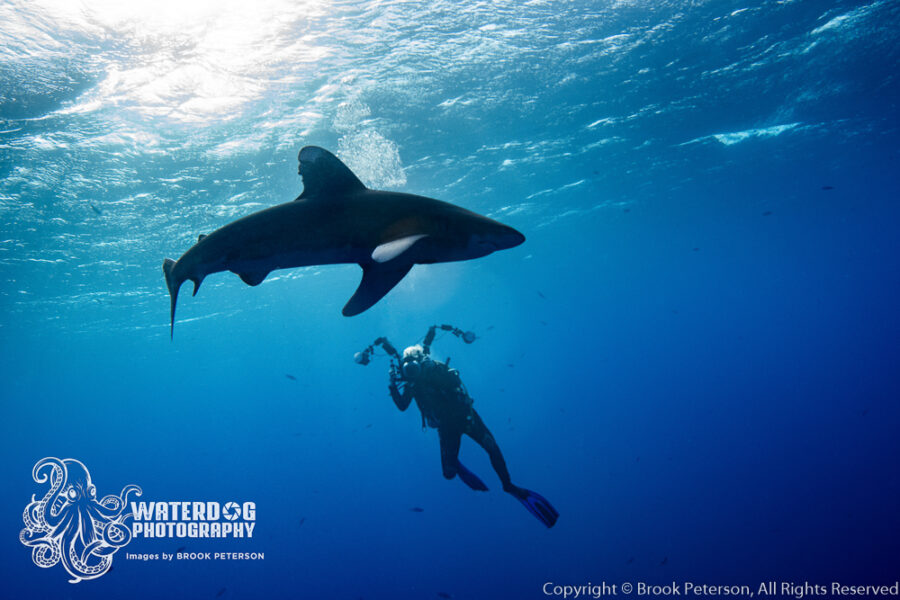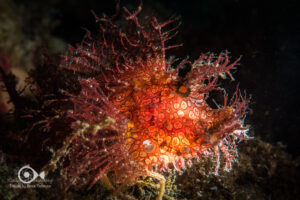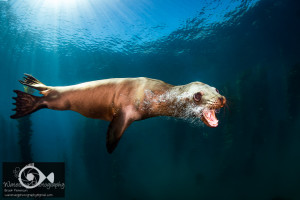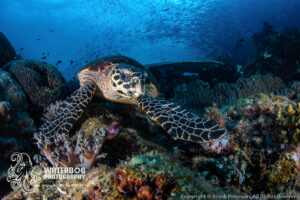The last few years have been productive for me in terms of having lots of opportunities to photograph sharks. I have had the pleasure of encountering many different species of reef sharks, oceanic white tip sharks, bull sharks, great white sharks, lemon, silky, dusky, and Galapagos sharks, and even whale sharks. Each of these have been a learning experience for me both environmentally and photographically speaking. The techniques for photographing sharks vary, depending on the species and environment you are in, but all opportunities are exhilarating.

There are different types of shark encounters. Some species such as great white sharks, will not likely approach divers unless there is bait in the water. Others, such as oceanic white tip sharks, are curious about divers and are attracted by the shadow of a large liveaboard boat, so no bait is required. I often desire a photograph in which the shark is close enough to fill the frame. For this reason, I am not against baiting for sharks because I believe good photographs of these beautiful creatures will aid in their conservation. That being said, if you plan to do a baited dive, make sure the company you are going with is experienced and licensed to conduct baited dives.

Although you can use a rectilinear wide angle lens, I typically use a fisheye lens when photographing sharks with an added 1.4 teleconverter. This reduces the width of the frame so that the shark does not appear too small. I prefer the rounder appearance that the fisheye lens gives the shark. If you are shooting just under the surface of the water, (for example, in a cage) you might consider shooting without strobes. You will have plenty of light from the sun. Under those circumstances, you can use a higher shutter speed and ISO to compensate for the light and a bit lower aperture since there will be nothing but water at the edges of your frame. In other words, you won’t have to worry about blur created by the dome port as a result of a lower aperture because there won’t be details at the edges of your frame.

If you are a little deeper and want to use strobes, keep them on the same plane as your housing about 18 inches or more apart. Be aware that if the shark comes in close to your dome you will have to pull the strobes in tighter so you don’t get a shadow on the face. Always stay aware of your surroundings as you shoot. If you have your eye to the viewfinder, you may not see an approaching shark.

Generally speaking, the best photographs have dimension to them. To achieve this, there should be something behind your subject to give perspective and a sense of depth. With sharks, you can use the bottom of a boat, a diver, or the surface of the water. Some of the most beautiful photographs contain dappled light from the sun or sunbeams coming down through the water.

I think it is important to show the behavior of any marine life if possible. Sharks have lots of different behaviors. At Roca Partida in the Revillagigedo Islands, you can typically see white tip reef sharks piled up on each other sleeping. Great white sharks have an intimidating mouthful of teeth so a shot with the mouth open is desirable. Reef sharks patrol the reef, so showing the reef in the background is a good idea. Whatever you observe or perceive you should try to capture in your photograph. Keep in mind that when a shark is behaving naturally, it will be more distant from you and your camera. You might consider using a longer lens, having your strobes placed widely apart and on high power and using a higher shutter speed and more open aperture so that the strobe light is more effective.
The best advice I can think of to give when shooting sharks is to think about what you want to achieve before hand. It can be chaotic and difficult to remember what you want to do with your camera when you are in the midst of an exciting shark dive. If you have something in mind before you go in to the water, and you set your camera up before hand, you will have a much better experience. You can even try to divide your time up into small increments, such as 15 minute intervals in which you re-evaluate what your goals are and take the time to adjust your camera settings. This way you will have a much better chance of getting the shot you want without compromising your safety or becoming frustrated with your results.
Join me for a workshop! Travel to a great destination where you will have exclusive coaching on your underwater photography. Meet new people, network, try new techniques, and learn with the pros! Click on Travel and Workshops for more information.
Subscribe now!
As always, if you enjoy my images please visit my website, waterdogphotography.com, or give me a like on Facebook at Waterdog Photography Brook Peterson. Don’t forget to follow me here at waterdogphotographyblog and please feel free to share on Facebook or other social media.
My photographs are taken with a Nikon D850 in Sea and Sea Housing using two YS-D2J Strobes.
All images and content are copyright protected by Brook Peterson and may only be used with written permission. Please do not copy or print them. To discuss terms for using these images, please contact me.
© Brook Peterson 2019

